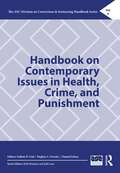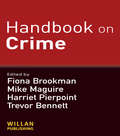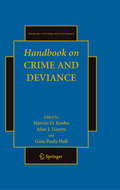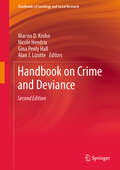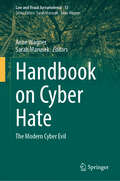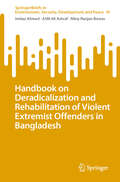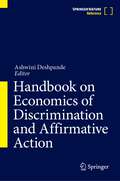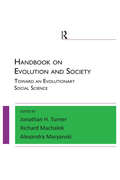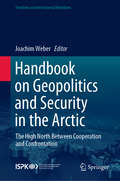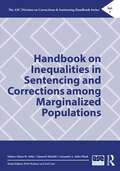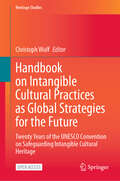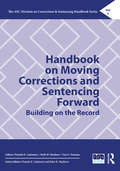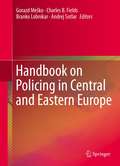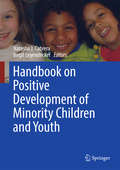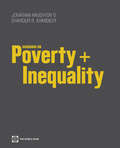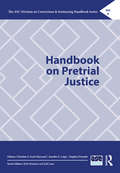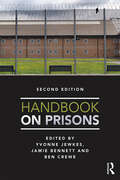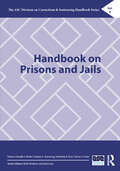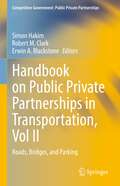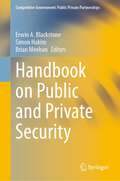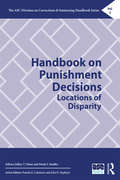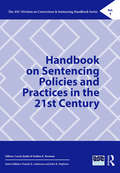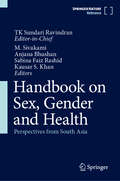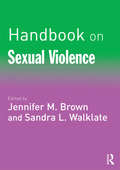- Table View
- List View
Handbook on Contemporary Issues in Health, Crime, and Punishment (The ASC Division on Corrections & Sentencing Handbook Series)
by Nathan W. Link Meghan A. Novisky Chantal FahmyThe Handbook on Contemporary Issues in Health, Crime, and Punishment covers many topics on the numerous ways in which mental and physical health and criminal justice system contact influence one another and are intricately intertwined. These often mutually reinforcing dynamics affect a range of health and justice outcomes at individual, familial, group, community, and national levels. Contributions detail this topic from a wide range of disciplinary, theoretical, and international perspectives and rely on various analytical lenses, including quantitative, qualitative, policy-analytic, theoretical/conceptual, and lived experiences.The chapters summarize what is known in each topical area, but as important, they identify emerging theoretical, empirical, and policy directions. In this way, the book is grounded in the current knowledge about the specific topic, but also provides new, synthesizing material that reflects the knowledge of the leading minds in the field. Conceptually divided into 11 sections, a number of contributions describe the unique experiences of women, people of color, juveniles, older populations, immigrants, LGBTQ+ individuals, and other sub-populations (i.e., people convicted of drug or sex offenses). Where appropriate, the authors provide both big picture and pragmatic policy directions aimed at reducing system contact, health challenges, and inhumane practices.Given its breadth and depth, the Handbook will appeal broadly to academics, practitioners, policymakers, advocates, and students seeking to understand the many ways in which health and justice system dynamics overlap.
Handbook on Crime
by Fiona Brookman Harriet Pierpoint Mike Maguire Trevor BennettThe Handbook on Crime is a comprehensive edited volume that contains analysis and explanation of the nature, extent, patterns and causes of over 40 different forms of crime, in each case drawing attention to key contemporary debates and social and criminal justice responses to them. It also challenges many popular and official conceptions of crime. This book is one of the few criminological texts that takes as its starting point a range of specific types of criminal activity. It addresses not only 'conventional' offences such as shoplifting, burglary, robbery, and vehicle crime, but many other forms of criminal behaviour - often an amalgamation of different legal offences - which attract contemporary media, public and policy concern. These include crimes committed not only by individuals, but by organised criminal groups, corporations and governments. There are chapters on, for example, gang violence, hate crime, elder abuse, animal abuse, cyber crime, identity theft, money-laundering, eco crimes, drug trafficking, human trafficking, genocide, and global terrorism. Many of these topics receive surprisingly little attention in the criminological literature. The Handbook on Crime will be a unique text of lasting value to students, researchers, academics, practitioners, policy makers, journalists and all others involved in understanding and preventing criminal behaviour.
Handbook on Crime and Deviance
by Alan J. Lizotte Gina Penly Hall Marvin D. KrohnThis handbook is designed to review the important recent developments in the sociology of crime and deviance. The chapters will identify and discuss the "hot topics" and the cutting edge research of the field. The work is divided into 5 major sections: - History of the Discipline, - Methodological Issues in Crime Research, - Explanations of Crime, - Theory-Based Practice,- Special Topics. The editors have organized a comprehensive treatment of the field of criminology at the turn of the 21st century.
Handbook on Crime and Deviance (Handbooks of Sociology and Social Research)
by Alan J. Lizotte Gina Penly Hall Marvin D. Krohn Nicole HendrixThis 2nd edition of the Handbook provides an interdisciplinary coverage of new understandings of the most important developments in the sociology of crime and deviance that is current and emerging for research, methodology, practice, and theory in criminology. It fosters research to take the fields of criminology and criminal justice in new directions. Unlike any other handbook, it includes chapters on cutting-edge quantitative data and analytical techniques that are shaping the future of empirical research and expanding theoretical explanations of crime and deviance. It further devotes a section to the most current and innovative methodological issues. Chapters are updated providing an inclusive discussion of the current research and the theoretical and empirical future of crime and deviance. This handbook is of great interest for advanced undergraduates, graduates students, researchers and scholars in criminology, criminal justice, sociology and related fields, such as social welfare, economics, and psychology.
Handbook on Cyber Hate: The Modern Cyber Evil (Law and Visual Jurisprudence #13)
by Anne Wagner Sarah MarusekCyberhate is defined as racist, discriminatory, negationist and violent statements made on social network platforms, text platforms, comment pages, and more. The Handbook on Cyber Hate, the Modern Cyber Evil, includes twenty-seven chapters from scholars representing over fifteen countries from the Global North and the Global South demonstrating a range of multi-faceted perspectives. While providing such a focus, these papers will also operate with a constantly evolving conceptualization of contemporary societies and their modern cyber-evil. Indeed, modern cyber-evil is a global concern and is primarily based on human minds and activities, and on deviant uses of modern technologies, which may differ ideologically, historically and culturally on the global map of modern legal systems. This plurality of perspectives, which poses a challenge to our future, is a strength of this handbook that offers a variety of foundations, legal perspectives, and popular developments in an effort to suggest measures to combat this modern cyber-evil infecting communications around the world. Editors Anne Wagner and Sarah Marusek offer a unique collection of chapters involving the theoretical foundations, legal perspectives, and societal perspectives from popular culture of modern cyber evil in order to address and combat racism on the basis of alleged race, skin color, nationality, descent and national or ethnic origin, etc.; discrimination/xenophobia on the basis of sex, gender, sexual orientation, religious or philosophical beliefs, health status, physical characteristics, etc.; hatred; violence; e-predation; and e-victimization. Advance Praise for “Handbook on Cyber Hate – The Modern Cyber Evil” “In 'Handbook on Cyber Hate – The Modern Cyber Evil', editors Anne Wagner and Sarah Marusek have masterfully created a much-needed resource for understanding the complex and ever-changing landscape of online hate and cyberbullying. This comprehensive handbook delves deep into the murky waters of cyberevil, offering insightful semiotic and transdisciplinary perspectives from a wide range of international scholars. Each chapter deftly navigates the theoretical, legal, and societal dimensions of cyberhate, shedding light on the complex interplay between technology, law, and culture. The book's exploration of cyber hate is not just academic, but a call to action. It encourages readers, denizens of the digital semiosphere, to recognize and combat the insidious nature of online hate, equipping them with knowledge and strategies for creating a safer digital world. Covering topics from the study of benign exhibitionism, the boundaries between speech and action in cyberhate, legal intricacies of that speech, trolling in social media and hegemonic masculinity, to the cinematic portrayal of cyberbullying and the malicious use of memes: this handbook is a beacon of hope and guidelines in our increasingly digital society. What sets this handbook apart is its holistic approach. It not only identifies problems, but in many cases inspires solutions, fostering a culture of responsible digital citizenship and empathy. This is not just a book, but a road map for creating a more inclusive and compassionate online community. As we face the challenges of the digital age, 'Handbook on Cyber Hate – The Modern Cyber Evil' is an indispensable handbook for researchers, educators, policy makers and all who seek to understand and combat the complexities of cyber hate. This is a must-read for shaping a more respectful and empathetic digital world.” Kristian Bankov, Professor of Semiotics, New Bulgarian University “In the present time of great confusion caused by the blurring of the lines of distinction between the real and virtual worlds, between artificial and human forms of intelligence and even between good and bad technologies representative for expressions of love and hate, the ‘Handbook on Cyber Hate – The Modern Cyber Evil’ brings an
Handbook on Deradicalization and Rehabilitation of Violent Extremist Offenders in Bangladesh (SpringerBriefs in Environment, Security, Development and Peace #41)
by Imtiaz Ahmed Niloy Ranjan Biswas ASM Ali AshrafThis Handbook provides a theory-driven and policy-relevant analysis of terrorist offenders' deradicalization processes. It is the product of a multi-year collaboration between security studies scholars and counterterrorism practitioners. It offers a multidimensional strategy for the physical and cognitive disengagement of terrorists. It also charts a path for the community-based social reintegration of rehabilitated extremist offenders. The Handbook is targeted for both academics and practitioners in the field of counterterrorism. Those specializing in South Asia and the Global South will find this book a useful reference tool to comprehend and design the complex deradicalization processes and transform them into implementable practices.
Handbook on Economics of Discrimination and Affirmative Action
by Ashwini DeshpandeThis Handbook deals with theoretical and empirical evidence on the economics of discrimination and affirmative action across the world, assessed over a variety of social identities, such as caste, race, ethnicity, gender, disability, age, tribal status. It also outlines methodological advances in this area, with plenty of additional references for the interested reader. It combines theoretical frameworks developed in the West with historical writings about discrimination and social justice from primarily Indian philosophers, aspects which are typically not found under one roof. It offers the reader a combination of insights into theories across a range of disciplines, as well as evidence, data –both quantitative and qualitative, in addition to the latest methodological advances in the estimation of discrimination – econometric, experimental, mixed-methods.
Handbook on Evolution and Society: Toward an Evolutionary Social Science
by Jonathan H. Turner Alexandra Maryanski Richard Machalek"Handbook on Evolution and Society" brings together original chapters by prominent scholars who have been instrumental in the revival of evolutionary theorizing and research in the social sciences over the last twenty-five years. Previously unpublished essays provide up-to-date, critical surveys of recent research and key debates. The contributors discuss early challenges posed by sociobiology, the rise of evolutionary psychology, the more conflicted response of evolutionary sociology to sociobiology, and evolutionary psychology. Chapters address the application and limitations of Darwinian ideas in the social sciences. Prominent authors come from a variety of disciplines in ecology, biology, primatology, psychology, sociology, and the humanities. The most comprehensive resource available, this vital collection demonstrates to scholars and students the new ways in which evolutionary approaches, ultimately derived from biology, are influencing the diverse social sciences and humanities.
Handbook on Geopolitics and Security in the Arctic: The High North Between Cooperation and Confrontation (Frontiers in International Relations)
by Joachim WeberAgainst the backdrop of climate change and tectonic political shifts in world politics, this handbook provides an overview of the most crucial geopolitical and security related issues in the Arctic. It discusses established shareholder's policies in the Arctic – those of Russia, Canada, the USA, Denmark, and Norway – as well as the politics and interests of other significant or future stakeholders, including China and India. Furthermore, it explains the economic situation and the legal framework that governs the Arctic, and the claims that Arctic states have made in order to expand their territories and exclusive economic zones. While illustrating the collaborative approach, represented by institutions such as the Arctic council, which has often been described as an exceptional institution in this region, the contributing authors examine potential resource and power conflicts between Arctic nations, due to competing interests. The authors also address topics such as changing alliances between Arctic nations, new sea lines of communication, technological shifts, and eventually the return to power politics in the area. Written by experts on international security studies and the Arctic, as well as practitioners from government institutions and international organizations, the book provides an invaluable source of information for anyone interested in geopolitical shifts and security issues in the High North.
Handbook on Inequalities in Sentencing and Corrections among Marginalized Populations (The ASC Division on Corrections & Sentencing Handbook Series)
by Eileen M. Ahlin Ojmarrh Mitchell Cassandra A. Atkin-PlunkThe Handbook on Inequalities in Sentencing and Corrections among Marginalized Populations offers state-of-the-art volumes on seminal and topical issues that span the fields of sentencing and corrections. The volume is a comprehensive and fresh approach to examining sentencing and community and institutional corrections. The book includes empirical and theoretical essays and recent developments on the pressing concerns of persons of traditionally non-privileged statuses, including racial and ethnic minorities, indigenous populations, gender, immigrant status, LGBTQ+, transgender, disability, aging, veterans, and other marginalized statuses. The handbook considers a wide range of perspectives for understanding the experiences of persons who identify as a member of a traditionally marginalized group. This volume aims to help scholars and graduate students by providing an up-to-date guide to contemporary issues facing corrections and sentencing. It will also assist practitioners with resources for developing socially informed policies and practices. This collection of essays contributes to the knowledge base by summarizing what is known in each area and identifying emerging areas for theoretical, empirical, and policy work. This is Volume 7 of The ASC Division on Corrections and Sentencing Handbook Series. The handbooks provide in-depth coverage of seminal and topical issues around sentencing and corrections for scholars, students, practitioners, and policymakers.
Handbook on Intangible Cultural Practices as Global Strategies for the Future: Twenty Years of the UNESCO Convention on Safeguarding Intangible Cultural Heritage (Heritage Studies)
by Christoph WulfThis open access handbook is the first to take stock of and to provide a comprehensive international interdisciplinary review of developments in living culture since the Convention on Safeguarding Intangible Cultural Heritage began in 2003. It is based on an expanded concept of culture, as it has been used in UNESCO since the 1980s and signed by more than 180 countries. The convention makes clear the significant role of the Global South in raising planetary awareness of the importance of intangible cultural practices. The first part of the book examines the relationship between the 1972 World Heritage Convention and the 2003 Convention on Intangible Cultural Heritage. The second part of the book focuses on colonialism, minorities, inequality, and the struggle for human rights. Perspectives from Nigeria, Brazil and the US show how colonialism still has a lasting effect today and what role the practices of intangible cultural heritage play in the struggles for the recognition of minorities. The third part looks at the contribution of intangible cultural heritage practices to the creation of meaning, community, and identity. How are these practices designed so that they allow as much participation as possible and lead to a successful handling of conflicts? The focus is on bottom-up processes. Part four examines several areas of aesthetics including music, dance, song, museum, architecture, and theater showing the importance of the aesthetic dimension and its contribution to the formation of individuals and communities. The fifth and final part of the book examines central problems of living culture and intangible cultural practices. This includes articles on new forms of community building, significance of digital and post-digital culture and metaphors. In the coming decades, intangible cultural heritage practices will become increasingly important for sustainable and peaceful planetary communication, to which the balance of this book and the perspectives based on it will make a significant contribution.
Handbook on Moving Corrections and Sentencing Forward: Building on the Record (The ASC Division on Corrections & Sentencing Handbook Series)
by Pamela K. Lattimore; Beth M. Huebner; Faye S. TaxmanThis volume addresses major issues and research in corrections and sentencing with the goal of using previous research and findings as a platform for recommendations about future research, evaluation, and policy. The last several decades witnessed major policy changes in sentencing and corrections in the United States, as well as considerable research to identify the most effective strategies for addressing criminal behavior. These efforts included changes in sentencing that eliminated parole and imposed draconian sentences for violent and drug crimes. The federal government, followed by most states, implemented sentencing guidelines that greatly reduced the discretion of the courts to impose sentences. The results were a multifold increase in the numbers of individuals in jails and prisons and on community supervision—increases that have only recently crested. There were also efforts to engage prosecutors and the courts in diversion and oversight, including the development of prosecutorial diversion programs, as well as a variety of specialty courts. Penal reform has included efforts to understand the transitions from prison to the community, including federal-led efforts focused on reentry programming. Community corrections reforms have ranged from increased surveillance through drug testing, electronic monitoring, and in some cases, judicial oversight, to rehabilitative efforts driven by risk and needs assessment. More recently, the focus has included pretrial reform to reduce the number of people held in jail pending trial, efforts that have brought attention to the use of bail and its disproportionate impact on people of color and the poor. This collection of chapters from leading researchers addresses a wide array of the latest research in the field. A unique approach featuring responses to the original essays by active researchers spurs discussion and provides a foundation for developing directions for future research and policymaking.
Handbook on Policing in Central and Eastern Europe
by Andrej Sotlar Charles B. Fields Gorazd Meško Branko LobnikarPolicing in Central and Eastern Europe has changed greatly since the fall of the Berlin Wall. Some Central and Eastern European countries are constituent members of the European Union, while others have been trying to harmonize with the EU and international requirements for a more democratic policing and developments in accordance with Western European and international policing standards, especially in regard to issues of legality and legitimacy. Changes in the police training system (basic and advanced), internationalization of policing due to transnationalization of crime and deviance, new police organizational structures and agencies have impacted new cultures of policing (from exclusively state to plural policing). This timely volume examines developments in the last two decade to learn the nature of these changes within Central and Eastern Europe, and their impact on police culture, as well as on society as a whole. The development of police research has varied widely throughout Central and Eastern Europe: in some countries, it has developed significantly, while in others it is still in its infancy. This work will allow for a transfer of ideas and models of police organization and policing is also need to be studies closely, with an aim to provide consistent and comparable data across all of the countries discussed. For the twenty countries covered, this systematic work provides: short country-based information on police organization and social control, crime and disorder trends in the last 20 years with an on policing, police training and police educational systems, changes in policing in the last 20 years, police and the media, present trends in policing (public and private, multilateral, plural policing), policing urban and rural communities, recent research trends in research on policing - specificities of research on police and policing (researchers and the police, inclusion of police researchers in policy making and police practice) and future developments in policing.
Handbook on Positive Development of Minority Children and Youth
by Natasha J. Cabrera Birgit LeyendeckerThis Handbook presents current research on children and youth in ethnic minority families. It reflects the development currently taking place in the field of social sciences research to highlight the positive adaptation of minority children and youth. It offers a succinct synthesis of where the field is and where it needs to go. It brings together an international group of leading researchers, and, in view of globalization and increased migration and immigration, it addresses what aspects of children and youth growing in ethnic minority families are universal across contexts and what aspects are more context-specific. The Handbook examines the individual, family, peers, and neighborhood/policy factors that protect children and promote positive adaptation. It examines the factors that support children's social integration, psychosocial adaptation, and external functioning. Finally, it looks at the mechanisms that explain why social adaptation occurs.
Handbook on Poverty and Inequality
by Jonathan Haughton Shahidur R. KhandkerHandbook on Poverty and Inequality was originally designed to support training courses in poverty analysis and inequality. The Handbook begins with an explanatory text that includes numerous examples, multiple-choice questions to ensure active learning, and extensive practical exercises that use Stata statistical software. The Handbook will help researchers and evaluators in charge of preparing background materials for Poverty Reducation Strategy Papers (PRSPs) and those responsible for monitoring and evaluating poverty reduction programs and policies. The World Bank Institute has used the Handbook in training workshops in countries from Bangladesh, India, and Pakistan, to Cambodia, Indonesia, the Philippines, and Thailand, to Malawi and Tanzania, as well as in university courses on poverty and in distance education courses with participants from Asian and African countries. The Handbook has also been used in an online asynchronous course with more than 200 participants worldwide. Using the feedback from these courses, the authors have created a clearly-written text that balances rigor with practicality. The Handbook is designed to be accessible to people with a university-level background in science or the social sciences. It is an invaluable tool for policy analysts, researchers, college students, and government officials working on policy issues related to poverty and inequality.
Handbook on Pretrial Justice (The ASC Division on Corrections & Sentencing Handbook Series)
by Scott-Hayward, Christine S.The Handbook on Pretrial Justice covers the front end of the criminal legal system from pretrial diversion to pretrial detention or release. Often overlooked, the decisions made at the earliest phases of the criminal legal system have huge implications for defendants and their families, the community, and the system itself, and impact the entire criminal legal system. This collection of essays and reports of original research explores the complexities of pretrial decisions and practices and includes chapters in the following broad areas: the consequences of detention, pretrial decision-making, community supervision, and risk assessment. The book also includes a section looking at pretrial justice outside of the U.S. Each chapter summarizes what is known, identifies the gaps in the research, and discusses the theoretical, empirical, and policy implications of the research findings. This is Volume 6 of the American Society of Criminology’s Division on Corrections and Sentencing handbook series. The handbooks provide in-depth coverage of seminal and topical issues around sentencing and correction for scholars, students, practitioners, and policymakers.
Handbook on Prisons
by Yvonne Jewkes, Ben Crewe and Jamie BennettThe second edition of the Handbook on Prisons provides a completely revised and updated collection of essays on a wide range of topics concerning prisons and imprisonment. Bringing together three of the leading prison scholars in the UK as editors, this new volume builds on the success of the first edition and reveals the range and depth of prison scholarship around the world. The Handbook contains chapters written not only by those who have established and developed prison research, but also features contributions from ex-prisoners, prison governors and ex-governors, prison inspectors and others who have worked with prisoners in a wide range of professional capacities. This second edition includes several completely new chapters on topics as diverse as prison design, technology in prisons, the high security estate, therapeutic communities, prisons and desistance, supermax and solitary confinement, plus a brand new section on international perspectives. The Handbook aims to convey the reality of imprisonment, and to reflect the main issues and debates surrounding prisons and prisoners, while also providing novel ways of thinking about familiar penal problems and enhancing our theoretical understanding of imprisonment. The Handbook on Prisons, Second edition is a key text for students taking courses in prisons, penology, criminal justice, criminology and related subjects, and is also an essential reference for academics and practitioners working in the prison service, or in related agencies, who need up-to-date knowledge of thinking on prisons and imprisonment.
Handbook on Prisons and Jails (The ASC Division on Corrections & Sentencing Handbook Series)
by Danielle S. Rudes Gaylene S. Armstrong Kimberly R. Kras TaLisa J. CarterThe Handbook on Prisons and Jails brings together some of the brightest scholars and thinkers in the field to offer a wide range of perspectives for understanding the experiences of persons incarcerated or working/volunteering within carceral institutions. The assembled chapters consider what is known in the area while identifying emerging areas for theoretical, empirical, and policy work. The volume includes contributions on numerous topics and areas related to penal control, containment, living, and/or working in carceral institutions and addresses methodological considerations for doing research with individuals incarcerated in jail or prison. This collection is essential reading for scholars and students seeking an up-to-date guide to contemporary issues facing corrections and sentencing. It also provides practitioners with valuable resources for developing socially informed policies and practices.
Handbook on Public Private Partnerships in Transportation, Vol II: Roads, Bridges, and Parking (Competitive Government: Public Private Partnerships)
by Erwin A. Blackstone Simon Hakim Robert M. ClarkSecond in a two-volume set, this book discusses the role of public-private partnerships (PPPs) in global transportation infrastructure, specifically focusing on roads, bridges, and parking. To provide vital services in an era of shrinking government budgets, public-private partnerships have become an increasingly important part of travel infrastructure worldwide. This book describes and analyses the structure of various models of PPPs in several countries, evaluating their effectiveness, and drawing policy implications for future use. The chapters were written by leading international researchers and practitioners in the transportation field where each chapter is a case study on the adoption, implementation, and outcome of transportation services. Taken together, these diverse case studies provide an integrated framework for evaluating, using PPPs, and suggesting policy implications to both the public and the private sectors in transportation. Providing rigorous empirical analysis of PPPs in transportation, this volume will be of interest to researchers in public administration, political science, public choice, and economics as well as practitioners and policymakers involved in establishing and monitoring PPPs in transportation.
Handbook on Public and Private Security (Competitive Government: Public Private Partnerships)
by Erwin A. Blackstone Simon Hakim Brian MeehanThis Handbook discusses the use of public-private partnerships in law enforcement and security. Written by international experts across multiple disciplines, chapters include case studies and cross-sectional industry-wide studies of private security performance in comparison with public police and collaborated experiences of the two sectors. The Handbook uses existing experiences and public economics to suggest how to improve security and social welfare through greater competition and cooperation between public and private security. This volume provides an integrated framework to assist policymakers in both public and private agencies. This Handbook will be an important reference for scholars in public economics, public administration, criminology, and criminal justice, as well as professionals and policymakers in the public and private sectors.
Handbook on Punishment Decisions: Locations of Disparity (The ASC Division on Corrections & Sentencing Handbook Series #2)
by Mindy S. Bradley Jeffery T. UlmerHandbook on Punishment Decisions: Locations of Disparity provides a comprehensive assessment of the current knowledge on sites of disparity in punishment decision-making. This collection of essays and reports of original research defines disparity broadly to include the intersection of race/ethnicity, gender, age, citizenship/immigration status, and socioeconomic status, and it examines dimensions such as how pretrial or guilty plea processes shape exposure to punishment, how different types of sentencing decisions and/or policy structures (sentencing guidelines, mandatory minimums, risk assessment tools) might shape and condition disparity, and how post-sentencing decisions involving probation and parole contribute to inequalities. The sixteen contributions pull together what we know and what we don’t about punishment decision-making and plow new ground for further advances in the field. The ASC Division on Corrections & Sentencing Handbook Series publishes volumes on topics ranging from violence risk assessment to specialty courts for drug users, veterans, or people with mental illness. Each thematic volume focuses on a single topical issue that intersects with corrections and sentencing research.
Handbook on Risk and Need Assessment: Theory and Practice (The ASC Division on Corrections & Sentencing Handbook Series #1)
by Faye S. TaxmanThe Handbook on Risk and Need Assessment: Theory and Practice covers risk assessments for individuals being considered for parole or probation. Evidence-based approaches to such decisions help take the emotion and politics out of community corrections. As the United States begins to back away from ineffective, expensive policies of mass incarceration, this handbook will provide the resources needed to help ensure both public safety and the effective rehabilitation of offenders. The ASC Division on Corrections & Sentencing Handbook Series will publish volumes on topics ranging from violence risk assessment to specialty courts for drug users, veterans, or the mentally ill. Each thematic volume focuses on a single topical issue that intersects with corrections and sentencing research.
Handbook on Sentencing Policies and Practices in the 21st Century (The ASC Division on Corrections & Sentencing Handbook Series)
by Cassia Spohn Pauline BrennanSentencing Policies and Practices in the 21st Century focuses on the evolution and consequences of sentencing policies and practices, with sentencing broadly defined to include plea bargaining, judicial and juror decision making, and alternatives to incarceration, including participation in problem-solving courts. This collection of essays and reports of original research explores how sentencing policies and practices, both in the United States and internationally, have evolved, explores important issues raised by guideline and non-guideline sentencing, and provides an overview of recent research on plea bargaining in the United States, Australia, and the United Kingdom. Other topics include the role of criminal history in sentencing, the past and future of capital punishment, strategies for reducing mass incarceration, problem-solving courts, and restorative justice practices. Each chapter summarizes what is known, identifies the gaps in the research, and discusses the theoretical, empirical, and policy implications of the research findings. The volume is grounded in current knowledge about the specific topics, but also presents new material that reflects the thinking of the leading minds in the field and that outlines a research agenda for the future. This is Volume 4 of the American Society of Criminology’s Division on Corrections and Sentencing handbook series. Previous volumes focused on risk assessment, disparities in punishment, and the consequences of punishment decisions. The handbooks provide a comprehensive overview of these topics for scholars, students, practitioners, and policymakers.
Handbook on Sex, Gender and Health: Perspectives from South Asia
by Tk Sundari RavindranThis Handbook is the first of its kind addressing gender issues in health in five countries of the South Asian Region, namely: Bangladesh, India, Pakistan and Sri Lanka. Adopting a social determinant of health perspective and an intersectionality and diversity lens, the Handbook illustrates the multi-layered complexities of gender, health, and well-being from the diverse perspectives and lived experiences in different South Asian countries. It includes studies on under-researched and often invisible marginalized populations, such as LGBTQI populations, urban poor, persons living with disability, migrant and conflict-affected populations. It represents the voices of the elderly, adolescents, and young people. It goes beyond analyzing the problem of gender inequities in health, and present examples of gender-transformative policies, programmes and social movement action. It is an essential resource for researchers, policy-makers, students in public health and community-based organizations involvedin research, policies, or programs related to sex work, public health, social justice and gender-based violence.
Handbook on Sexual Violence
by Jennifer M. Brown Sandra L. WalklateThis book contextualizes the complexity of sexual violence within its broader context – from war to the resolution of interpersonal disputes – and covers a wide span including sexual harassment, bullying, rape and murder as well as domestic violence. Written by leading academics from a variety of disciplines, contributions also include commentaries that relate the research to the work of practitioners. Despite advances made in the investigation of sexual offences, evidence still points to a continued belief in the culpability of victims in their own victimization and a gap between the estimated incidence of sexual violence and the conviction of perpetrators. Adopting an implicitly and explicitly critical stance to contemporary policy responses that continue to fail in addressing this problem, this book focuses on attitudes and behaviour towards sexual violence from the point of view of the individual experiencing the violence – perpetrator and victim – and situates them within a broader societal frame. It is through an understanding of social processes and psychological mechanisms that underpin sexual violence that violence can be combated and harm reduced, and at this individual level that evidence-based interventions can be designed to change policy and practice. The Handbook is split into four sections: 'Legacies: Setting the Scene' offers a critical overview of historical, legal and cultural processes which help to explain the origins of current thinking and offer steers for future developments 'Theories and Concepts' examines contemporary thinking on sexual violence and reviews explanatory frameworks from a number of perspectives 'Acts of Sexual Violence' reviews a number of specific types of sexual violence, elaborating the range of circumstances, victims and perpetrators with a view to addressing the general and pervasive nature of such violence thus contradicting narrow cultural stereotyping 'Responding to Sexual Violence' overviews and evaluates current policies and practices and offers new ideas to develop different types of interventions. The editors’ conclusion not only draws out the key themes and ideas from contributions to the Handbook, but also considers the nature of and the extent to which any progress has been made in understanding and responding to sexual violence. This will be a key text for students and academics studying sexual violence and an essential reference tool for professionals working in the field including police officers, probation staff, lawyers and judges.
